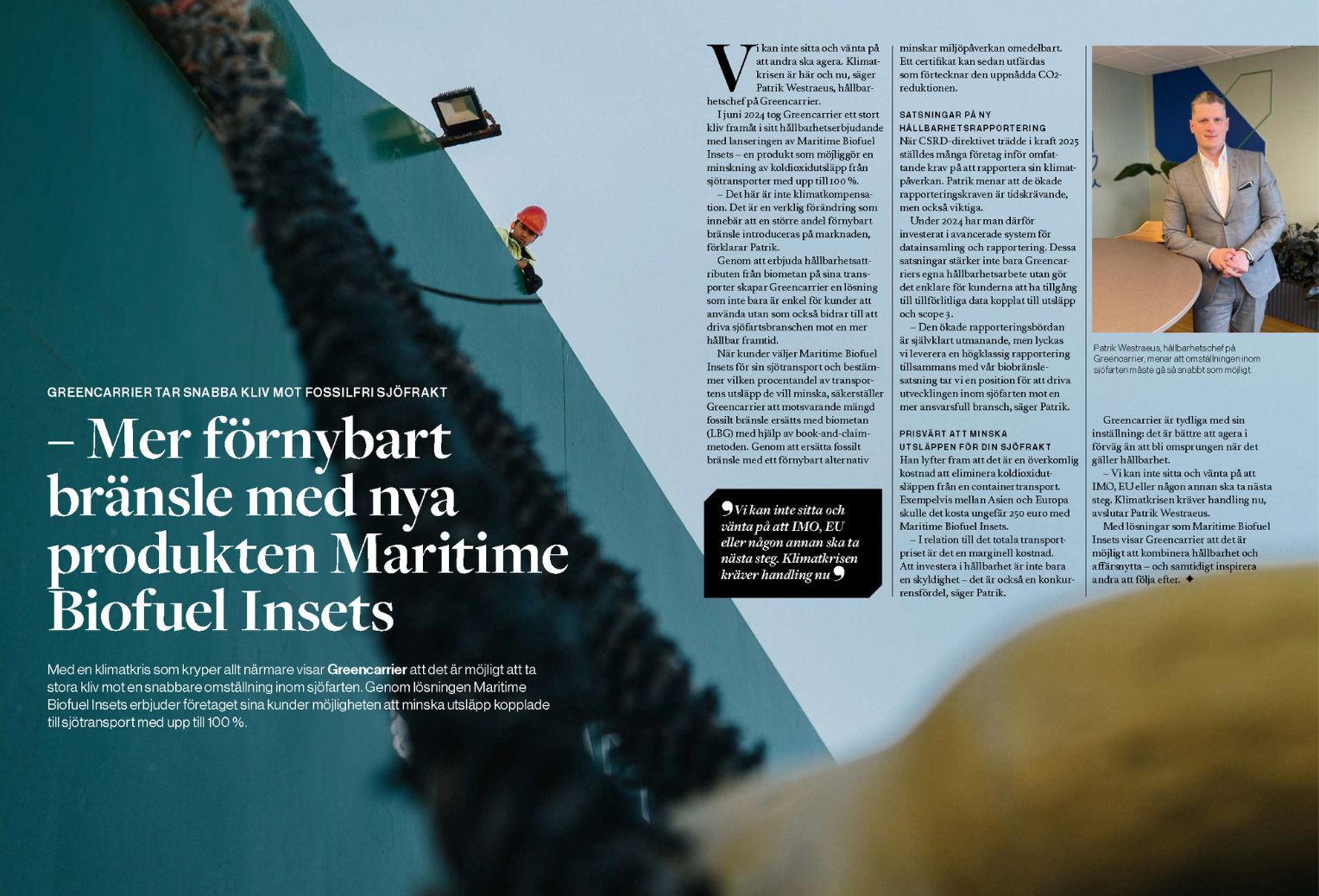As the calendar turns to a new year, new shipping regulations take effect. Keeping track of them all, understanding what they mean and how they affect you, can be challenging. To help you out, I will explain 5 important shipping regulations in 2023 for you to keep tabs on.
Targets that drive sustainable shipping
Before we jump into the new shipping regulations, let us look at some of the targets driving sustainable international shipping.
The EU aims to be climate-neutral by 2050. This objective is at the heart of the European Green Deal and in line with the EU’s commitment to global climate action under the Paris Agreement. As an intermediate step towards the 2050 goal, the EU has set the target to reduce greenhouse gas (GHG) emissions by at least 55% by 2030. The Fit for 55 package is a set of proposals for revising existing legislation and new initiatives. It aims to bring EU legislation in line with the 2050 goal and turn climate goals into EU law.
The International Maritime Organization (IMO) has also set ambitious targets. As part of their GHG Strategy, they aim to reduce GHG emissions by at least 50% by 2050 compared with their 2008 level. They also aim to phase out GHG emissions from international shipping entirely as soon as possible in this century.
5 shipping regulations in 2023 to keep tabs on
Now, let us jump into international shipping regulations worth keeping tabs on in 2023, what they mean, and how they affect you as a shipowner or ship operator.
The IMO 2023 regulation
As part of their GHG strategy, the IMO has launched a new set of rules called the IMO 2023 regulation. The regulation aims to reduce carbon emissions from international shipping. It introduces mandatory reductions in carbon emissions for both new and existing ships, using energy efficiency indicators to determine these levels. The updates to the IMO 2023 regulation include CII and EEXI, which are described below.
1. CII – Carbon Intensity Indicator
The CII is a new global metric used to measure the carbon emissions generated by shipping activities. The CII is calculated as the amount of carbon dioxide (CO2) emissions generated per tonne of cargo transported per kilometre. The CII aims to reduce the carbon footprint of ships and shipping companies to limit their contribution to climate change. Starting in 2023, each vessel will receive a grade from good (A) to poor (D). Ships that receive an E grade will have to put a corrective plan in place.
How does CII affect me as a shipowner or ship operator?
You must comply with the CII by monitoring and reporting your ship’s carbon emissions according to the guidelines set out by the IMO. You need to collect data on fuel consumption and CO2 emissions and submit regular reports to the IMO. You must also
take steps to improve energy efficiency and reduce carbon emissions with yearly tightening emission reduction targets. To meet the IMO CII reduction targets, shipowners need to invest in new technologies such as more fuel-efficient engines, switching to alternative fuels, and improving hull design, as well as adopting best practices for ship operations, such as optimised speed and route planning to minimise fuel consumption.
2. EEXI – Energy Efficiency Existing Index
The EEXI is a rating system that assesses the energy performance of existing ships based on energy consumption data and other key metrics such as speed, power, and engine size. The measure is related to the technical design of a ship and based on the ship’s specifications, not its actual operating performance. EEXI aims to reduce the greenhouse gas emissions of ships. From 1 January 2023, it is mandatory for all ships to calculate their attained EEXI to measure their energy efficiency and initiate data collection to report their annual operational CII and CII rating.
How does EEXI affect me as a shipowner or ship operator?
Your ship must be approved by the first periodical survey 2023. You need to calculate the EEXI value of your vessel, compare it to the required value, improve the energy efficiency of your ship if necessary, and submit the document for approval. If your vessel receives an EEXI rating below a certain threshold, you may be subject to IMO 2023 penalties and restrictions. To attain EXXI approval, you may have to modify engines or systems, such as adopting engine or shaft power limitations In fact, reducing speed by 20% can drop the emitted CO2 by 50%. Other options are energy-saving devices or clean technologies such as using batteries or zero-carbon fuels.
The MARPOL 2023 regulation
The MARPOL 2023 regulation is a crucial update to the International Convention for the Prevention of Pollution from Ships. It was developed by the IMO with the goal of minimising pollution of the oceans and seas, including dumping, oil and air pollution. The MARPOL 2023 regulation includes updates to SEEMP, which will be described below.
3. SEEMP Part III – Ship Energy Efficiency Management Plan
The SEEMP aims to improve the energy efficiency of ships and manage ship efficiency performance over time. The SEEMP Part III is an update to SEEMP Part I and II. SEEMP Part III includes new requirements and guidance for calculating and reporting ships’ annual operational CII and a plan documenting how the required annual operational CII should be achieved during the next three years. It also includes a procedure for self-evaluation and improvement as well as a plan of corrective actions, if needed.
How does SEEMP III affect me as a shipowner or ship operator?
You must have a verified plan in place for how your vessel is going to achieve its CII targets. This should be a dynamic document that is kept onboard the ship. You need to calculate your current CII rating and articulate your three-year target. You might have to implement energy efficiency measures such as new technology and equipment investments to improve your ship’s energy efficiency. Each year, you need to update the document with prevailing fuel consumption data, track your CII performance and the effectiveness of your energy efficiency measures, and evaluate your plan.
4. EEDI– Energy Efficiency Design Index
EEDI is used to measure and compare the carbon dioxide emissions of ships and sets minimum efficiency requirements for new ships. It is calculated using a formula that takes into account a ship’s size, capacity, and speed, as well as the efficiency of its propulsion and energy systems. The resulting number represents the amount of CO2 emissions the ship is expected to produce per unit of cargo carried over a defined distance. The EEDI aims to promote the use of more energy-efficient equipment and engines.
How does EEDI affect me as a shipowner or ship operator?
New ships must comply with minimum energy efficiency standards. If not, they may not be approved for operation. This could result in additional costs, as you may need to modify your vessels. Currently, the EEDI only applies to vessels responsible for the most emissions. However, as a shipowner or ship operator, it is wise to consider that EEDI requirements will be tightened every five years. Ships built between 2022 and 2025 will have to meet even higher standards.
5. EEOI – Energy Efficiency Operational Indicator
EEOI is a measure used to track the energy efficiency of ships. It is defined as the ratio of a ship’s transport work (measured in tonne-miles) to the total energy consumed (measured in tonne-hours) during its operation. The EEOI is used to compare different ships’ energy efficiency and monitor changes in a ship’s energy efficiency over time.
How does EEOI affect me as a shipowner or ship operator?
The EEOI is not yet mandatory for shipowners or ship operators, although it has been up for discussion. However, the IMO uses the EEOI to evaluate the compliance of ships with environmental regulations, including the IMO’s GHG reduction targets. As such, it is important for you to be aware of your ship’s EEOI and take steps to improve it where possible. EEOI is also a parameter that refers to the actual carbon intensity of a vessel, which is the prime concern of the CII.
Towards a more sustainable shipping industry
To sum it up, the new shipping regulations in 2023 will create both challenges and opportunities for shipowners and ship operators. Investments are needed to comply with the new regulations but also to create a more sustainable shipping industry. I hope this article contributes to helping you navigate the rapidly changing shipping industry – and encourages you to be part of this positive change.
Do you want to learn more about sustainable shipping? Here are two reading tips:
- What role does smart ship design play in reaching carbon neutrality?
- Debunking 3 myths about green shipping
To learn more about Greencarrier Liner Agency and what we do, visit our website.





